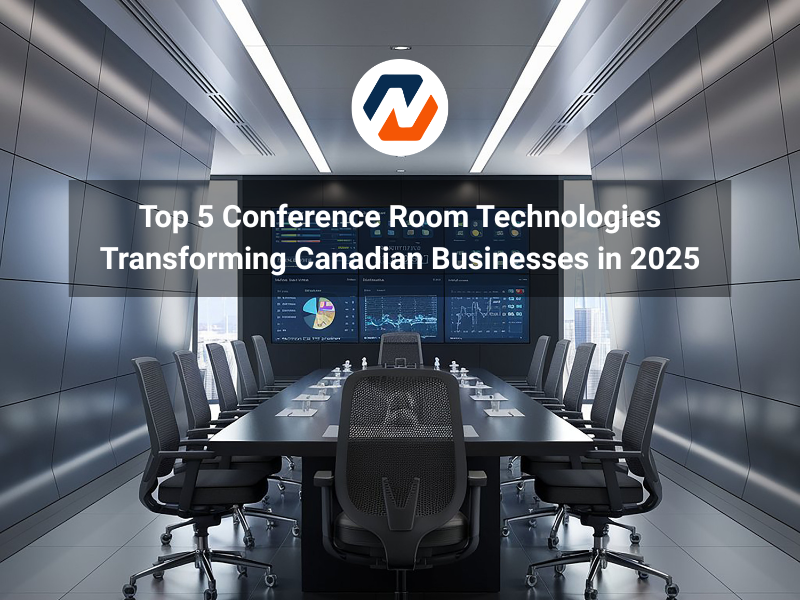admin2025-10-04T10:23:22+00:00
Table of Contents
ToggleIntroduction
In 2025, Canadian businesses are rethinking how they collaborate. With hybrid work models becoming the new norm, the demand for advanced conference room technologies has skyrocketed. From AI-powered cameras to dual-display boardrooms, organizations are investing in AV systems that boost productivity, cut costs, and improve employee engagement.
According to Microsoft Canada, companies with hybrid-enabled rooms report 45% higher employee engagement, while IDC notes that Canadian enterprises adopting modern AV setups have reduced travel costs by 28%.
So, which technologies are shaping the future of meeting spaces in Canada? Let’s explore the Top 5 Conference Room Technologies in 2025
1. AI-Powered Cameras
Why It Matters
Traditional PTZ (pan-tilt-zoom) cameras require manual adjustments and often miss critical interactions. AI-powered cameras automatically frame speakers, track movement, and provide wide-angle coverage, ensuring remote participants feel fully included.
Real Impact in Canada
A Toronto enterprise recently adopted AI-driven cameras across its boardrooms and reported a 41% increase in remote employee participation during hybrid meetings.
Use Cases
- Executive boardrooms.
- Hybrid classrooms.
- Healthcare consultations.
2. Dual-Display & Multi-Screen Setups
Why It Matters
In hybrid meetings, one display isn’t enough. Canadian businesses are standardizing dual-screen setups—one for video participants and one for shared content. This separation improves focus and reduces distractions.
Real Impact
According to PwC Canada (2025), companies with dual-display boardrooms achieved 32% faster decision-making cycles compared to single-screen setups.
Use Cases
- Corporate boardrooms.
- Financial institutions reviewing dashboards.
- Universities hosting hybrid lectures.
3. Beamforming Ceiling Microphones
Why It Matters
Table microphones clutter surfaces and often miss voices. Beamforming ceiling microphones use intelligent directional pickup, capturing every voice in the room without needing multiple devices. They are also touchless and hygienic—a growing priority in 2025.
Real Impact
Ontario hospitals deploying ceiling microphones saw a 42% improvement in telehealth consultation efficiency (CMAJ Report, 2025).
Use Cases
- Healthcare telehealth rooms.
- Government council chambers.
- Training rooms and auditoriums.
4. LED Video Walls & Large Displays
Why It Matters
LED video walls are replacing projectors due to their brightness, clarity, and energy efficiency. They deliver vivid visuals that make presentations, data dashboards, and hybrid events more impactful.
Real Impact
Event venues in Vancouver that upgraded to LED walls saw a 34% increase in corporate event bookings (Canadian Hospitality Outlook, 2025).
Use Cases
- Hospitality & event spaces.
- Corporate town halls.
- Manufacturing & engineering design reviews.
5. Touch Panel Controls & Room Scheduling Systems
Why It Matters
Confusing technology wastes time. Touch panels simplify room management with one-touch join, room scheduling, and centralized control for lighting, AV, and conferencing.
Real Impact
A Montreal tech firm deployed integrated touch panels and reduced meeting start delays by 27%, improving productivity across its offices.
Use Cases
- Enterprise offices.
- Financial services boardrooms.
- Public sector institutions.
Bonus Trend: Encrypted & Compliance-Ready AV
Especially for financial services, healthcare, and government, end-to-end encryption and compliance-ready recording are becoming mandatory. In 2025, Canadian firms are prioritizing secure AV to meet PIPEDA, HIPAA, and FINTRAC requirements.
Conclusion
The way Canadian businesses meet is evolving rapidly. From AI-powered cameras to LED walls and touchless microphones, conference room technologies are delivering measurable ROI across every sector.
- Productivity – 29% faster project cycles (Deloitte Canada, 2025).
- Travel Costs – 28–40% reduction (IDC, PwC, 2025).
- Engagement – 41–45% more participation (Microsoft Canada, 2025).

